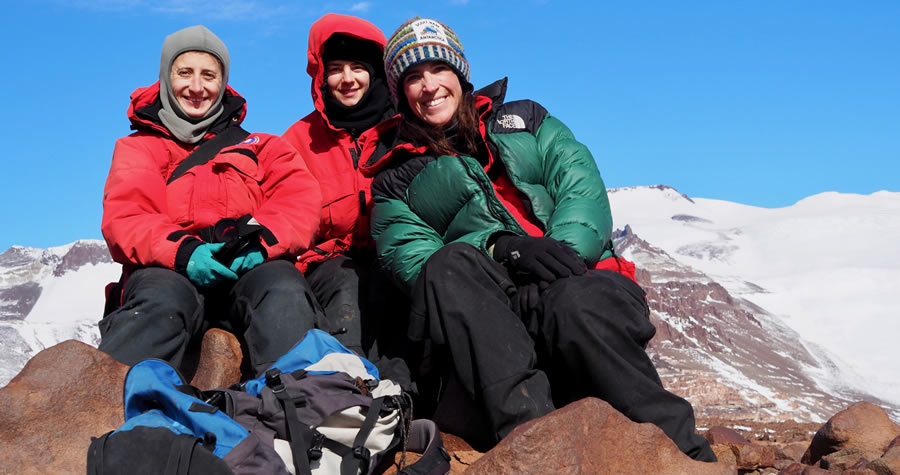
Antarctica’s unique climate enticed UNC Charlotte earth sciences researcher Martha Cary Eppes and her research colleagues to spend weeks camping in a tent in sub-zero temperatures, in order to literally monitor and listen to rocks as they fracture. They are studying how rocks alter and erode in one of the most extreme environments on the planet.
Eppes has just returned to UNC Charlotte from Beacon Valley, Antarctica, and is now poring through photographs and data collected during the extreme explorations, funded by the National Science Foundation Office of Polar Programs.
“To accurately interpret any geologic feature or phenomenon, we must understand how and why it changes through time,” Eppes said. “In particular, in the Dry Valleys, we have a poor understanding of the rates and causes of one of Earth's most fundamental geologic processes, physical rock breakdown. For example, the Dry Valleys lack moisture, which is thought to play a key role in rock cracking in most other locations on the planet. We need to better understand what causes rocks to fracture in this seemingly inert environment.”
Studying how rocks break down is important to more accurately understand the paleoclimates and landscapes of Antarctica, elsewhere on Earth, and possibly even Mars. Measurements on the samples gathered will allow the researchers to see how quickly rocks break down and how their characteristics change over geologic time.
Eppes, principal investigator Jennifer Lamp of Columbia University, and consultant Kate Swanger of University of Massachusetts Lowell in late November 2018 arrived at the McMurdo Station, which is the logistics hub of the U.S. Antarctic Program. One of three U.S. Antarctic research stations, McMurdo Station is the largest in Antarctica; the station provided logistical support for the team’s work.
A week after their arrival, a helicopter transported the three-woman research team from McMurdo Station to their isolated field camp in Beacon Valley, where they camped for nearly a month.
“Being left alone in Beacon was like being dropped off by a time machine to Earth before there was life,” Eppes said. “The only known living beings there are 16 species of bacteria.”
From a rustic camp, the research team instrumented boulders with sensors that acted as miniature seismographs, recording even the smallest micro-cracking on and within the rocks. Their micrometeorological sensors also collected data on surface temperatures and surface moisture. They constructed a full meteorological station to gather data on wind speed and direction, air temperature and relative humidity, solar irradiance and air pressure.
“Instrumenting the boulders in Antarctica posed severe challenges,” Eppes said. “Handling tiny wires in freezing temperatures is almost impossible. Also, the cold temperatures kept our glue from drying. Nevertheless, it turns out that we were very lucky with the weather. On the day after all of the sensors were finalized, we recorded 80 mph winds with our weather station.”
 In addition to instrumentation, the team collected samples. Even simple sample collection becomes extreme in Antarctica. On one occasion, a helicopter-supported day trip dropped the team near the headwall of Mullins Glacier on which they were camping. They hiked across rocky terrain from that headwall back to their campsite, collecting more than 100 pounds of samples along the way.
In addition to instrumentation, the team collected samples. Even simple sample collection becomes extreme in Antarctica. On one occasion, a helicopter-supported day trip dropped the team near the headwall of Mullins Glacier on which they were camping. They hiked across rocky terrain from that headwall back to their campsite, collecting more than 100 pounds of samples along the way.
“Life in a remote field camp in Antarctica was, on one hand, like living in a fairy world,” Eppes said. “I was moved to tears at times by its solitude and beauty. On the other hand, the work comprised a very familiar routine for me as a field scientist, with its long days of work followed by lots of laughter and good conversations with colleagues around a camp stove, cooking up stir-fry or beans and rice.”
In addition to the scientific achievements of this project, it supports female researchers in a discipline and on a continent where women are still largely underrepresented. The project also will provide a unique exposure and experience for students, ranging from elementary students who will learn about the work through presentations by the researchers, to the undergraduate and graduate students who are working directly on various aspects of the project.
Back at UNC Charlotte, Eppes will bring the research into her classroom, using what she is learning as real-world examples. Future graduate students will help to analyze the data and the rock samples that will arrive back from Antarctica by boat sometime in April.
Eppes is unsure if she would return to Antarctica, at least not in the near future, mostly due to the toll her travels took on her children.
“But I have many years’ worth of data to analyze and memories that I wouldn’t trade for the world,” she said.
In addition to the work in Antarctica, Eppes is conducting research in the Piedmont of South and North Carolina, the Blue Ridge of Virginia, granite domes of California and the Eastern United States and the alpine environments of the San Juan Mountains of Colorado. Some of her work also has focused on Mars.
Photos: Kate Swanger, Jennifer Lamp and Martha Cary Eppes conducted research in a discipline and on a continent where women are still largely underrepresented. Inset, Eppes melted snow from the top of the glacier for water, which she kept in her trusty 49ers thermos.